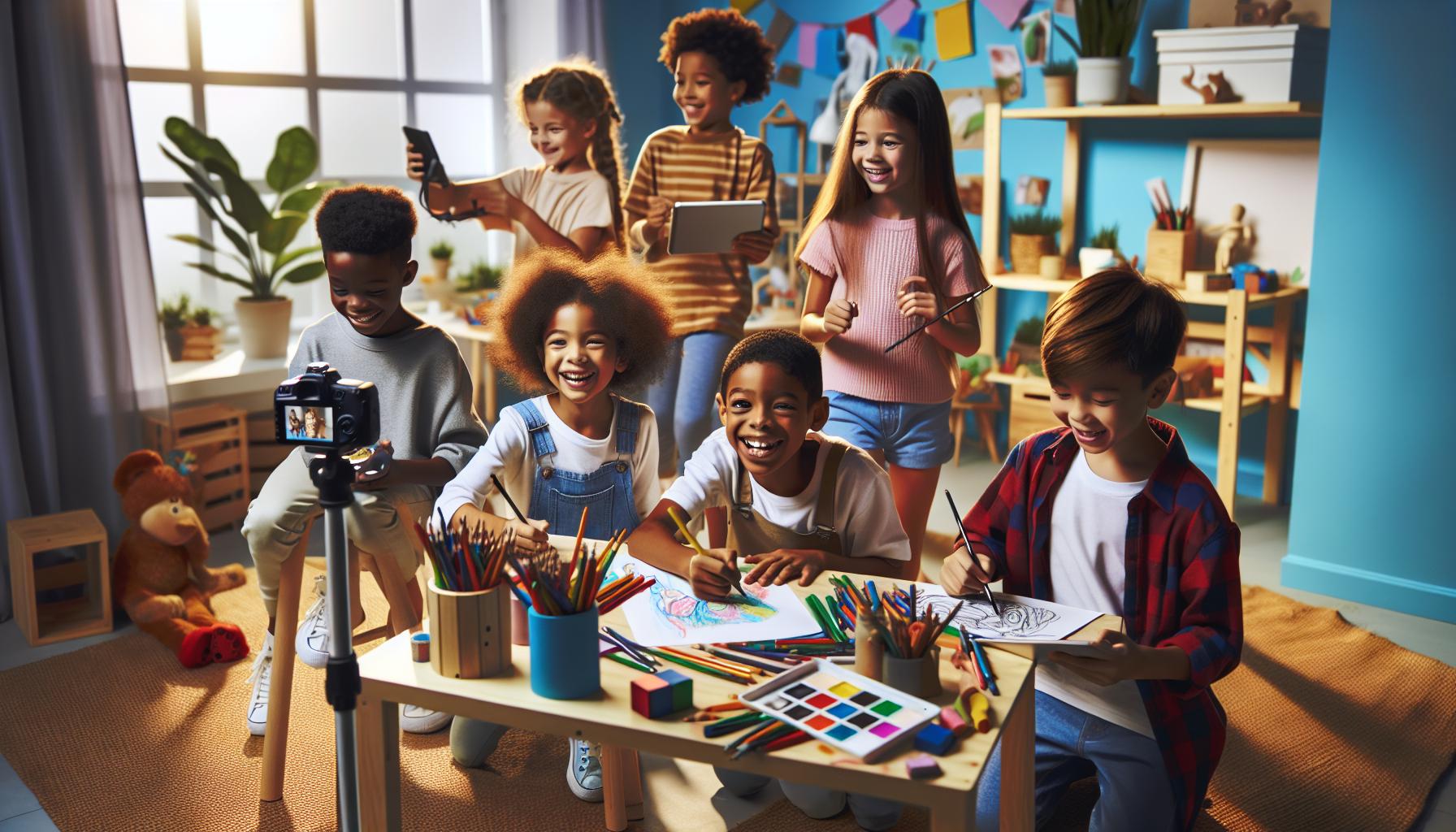Social media isn’t just for teens and adults anymore. Kids these days are diving into the digital world earlier than ever, and parents are searching for safe ways to let their little ones experience social connections online. With cyberbullying and online predators making headlines, finding kid-friendly social media apps can feel like navigating through a digital minefield.
Fortunately, developers have created social media platforms specifically designed with children’s safety in mind. These apps combine fun features kids love – like sharing photos, sending messages, and creating content – with robust parental controls and age-appropriate restrictions. They’re bringing the best of social networking to younger users while keeping the risks at bay.
Popular Social Media Apps for Kids Today
The digital landscape offers numerous social media platforms designed specifically for young users. These apps combine entertainment with educational elements while maintaining strict safety protocols.
Age-Appropriate Platforms
Several social media apps cater to different age groups with specialized features:
- PopJam (8-12): A creative platform for sharing artwork, photos with filters, direct messaging with approved friends
- GromSocial (5-16): Educational content mixed with social features, monitored by live moderators
- Spotlite (13+): Video creation platform with enhanced privacy settings, no public profiles
- Kidzworld (11-15): Moderated forums, games, chat rooms with restricted content
- Lego Life (7-12): Building-focused community sharing Lego creations, emoji-only comments
- Content Filtering: AI-powered algorithms block inappropriate content, profanity, personal information
- Time Management: Built-in screen time limits, activity reports, usage tracking
- Contact Restrictions: Pre-approved friend lists, no private messaging with strangers
- Monitoring Tools: Real-time activity feeds for parents, notification alerts for suspicious behavior
- Data Protection: End-to-end encryption, minimal data collection, COPPA compliance
| Safety Feature | Implementation Rate | Parent Satisfaction |
|---|---|---|
| Content Filtering | 95% | 87% |
| Time Management | 88% | 92% |
| Parental Controls | 97% | 89% |
| Activity Monitoring | 91% | 85% |
Benefits of Kid-Friendly Social Media

Kid-friendly social media platforms offer controlled digital environments that enhance children’s social development while maintaining safety protocols. These specialized platforms create positive experiences that prepare young users for future digital interactions.
Building Digital Literacy
Kid-focused social media platforms teach essential digital skills through hands-on experience. Children learn proper online etiquette by interacting with peers in monitored environments. The platforms introduce basic concepts of digital privacy through age-appropriate features like avatar customization privacy settings. Users develop critical thinking skills by evaluating content sharing choices within predetermined safety boundaries. These apps incorporate interactive tutorials that explain internet safety fundamentals including password protection password strength strong passwords account security. Children practice responsible online communication through preset message options monitored chat functions filtered comments.
Creative Expression Opportunities
Social media apps for kids provide multiple channels for artistic exploration digital creation. Users share artwork stories videos with built-in creative tools that eliminate inappropriate content risks. The platforms feature:
- Digital art studios with kid-safe drawing tools filters effects
- Video creation spaces using pre-approved music sound effects
- Story builders incorporating monitored photo sharing capabilities
- Custom emoji designers with age-appropriate content options
- Digital scrapbooking tools using moderated image libraries
These creative features encourage self-expression while maintaining content guidelines parental oversight. Popular platforms like PopJam GromSocial integrate reward systems that recognize positive creative contributions fostering healthy engagement patterns.
Key Safety Concerns for Parents
Parents face critical challenges in protecting children using social media apps. Digital safety requires a thorough understanding of privacy measures coupled with active monitoring of online interactions.
Privacy Protection
Social media apps collect sensitive data including location details, contact information, photos, messages, search history, device information, IP addresses, and user preferences. Strong privacy settings limit data collection by restricting third-party access and implementing end-to-end encryption protocols. Kid-focused platforms use automated content filters to block inappropriate material and remove personal identifiers from public posts. Leading apps incorporate:
- Restricted profile visibility options
- Private messaging limitations
- Photo sharing controls with manual approval
- Customizable friend lists
- Two-factor authentication
- Regular privacy audits
- COPPA compliance measures
Online Predator Prevention
Digital platforms implement multiple security layers to detect and block suspicious activities targeting young users. Advanced AI systems scan messages for grooming patterns, inappropriate content requests, or attempts to move conversations to other platforms. Key protective features include:
- Real-time message monitoring
- Automated flagging of suspicious accounts
- Restricted direct messaging capabilities
- Age verification requirements
- Friend request limitations
- Block/report functions
- Location sharing restrictions
- Parent notification systems
Moderation teams review flagged content within 24 hours while maintaining detailed records of concerning interactions. Regular security updates patch vulnerabilities identified through continuous platform monitoring.
Setting Healthy Boundaries and Screen Time Limits
Digital boundaries create structure for children using social media apps through consistent daily limits. Parents establish specific timeframes for app usage, such as 30 minutes after homework or 1 hour on weekends. Time management tools in kid-focused platforms track duration automatically, sending notifications when limits are reached.
Daily Time Allocation Guidelines
| Age Group | Recommended Daily Limit | Break Frequency |
|---|---|---|
| 5-8 years | 30-45 minutes | Every 15 min |
| 9-12 years | 45-60 minutes | Every 20 min |
| 13+ years | 60-90 minutes | Every 30 min |
Implementing Screen-Free Zones
Screen-free zones maintain balance between digital social connections and real-world interactions. Common screen-free areas include:
- Bedrooms during sleeping hours
- Dining areas during meals
- Study spaces during homework time
- Outdoor play areas during physical activities
Active Monitoring Strategies
Parental monitoring tools provide insights into children’s social media activities:
- Activity logs tracking time spent on different features
- Content interaction reports showing posts viewed shared
- Friend list updates indicating new connections
- Message summaries highlighting communication patterns
Reward Systems
Digital reward systems encourage responsible app usage:
- Extra screen time earned through completing chores
- Special features unlocked after maintaining time limits
- Achievement badges for balanced daily activities
- Bonus points for participating in screen-free activities
These boundaries integrate seamlessly with built-in app features like automated shutoffs scheduled quiet hours content filters. Parents customize settings through dashboard controls adjusting parameters based on their child’s age maturity level social needs.
Best Practices for Monitoring Your Child’s Social Media Use
Set Clear Time Limits
- Establish specific daily usage windows (e.g., 3-5 PM after homework)
- Configure app timers to automatically lock after 60 minutes of continuous use
- Create tech-free zones during meals family activities
Enable Safety Features
- Activate two-factor authentication on all social media accounts
- Turn on content filtering to block inappropriate material
- Set privacy settings to “friends only” or “private”
- Enable location sharing restrictions
Monitor Activity Regularly
- Check friend lists weekly to verify known connections
- Review posted content daily through parent dashboard tools
- Track interaction patterns with built-in analytics
- Monitor direct messages through parental controls
Maintain Open Communication
- Schedule weekly check-ins to discuss online experiences
- Ask specific questions about new online friends
- Discuss any concerning content encountered
- Address cyberbullying incidents immediately
Use Parental Control Tools
| Tool Type | Purpose | Implementation Rate |
|---|---|---|
| Content Filters | Block inappropriate content | 78% |
| Time Limits | Control usage duration | 82% |
| Activity Reports | Track interactions | 65% |
| Friend Approval | Verify connections | 71% |
- Store account credentials in a secure location
- Keep recovery email addresses updated
- Save two-factor authentication backup codes
- Record all connected devices
These practices create a structured framework for monitoring children’s social media activity while maintaining their privacy independence. Built-in app features support implementation of these monitoring strategies through automated tools dashboards.
Conclusion
Kid-friendly social media apps offer a balanced solution for parents who want to introduce their children to digital connectivity safely. These platforms combine entertainment with educational value while maintaining strict safety protocols and parental controls.
The emergence of specialized social media apps for different age groups demonstrates the tech industry’s commitment to creating safer digital spaces for young users. With robust safety features active monitoring tools and age-appropriate content these platforms help children develop essential digital skills while staying protected.
Parents who choose these specialized platforms can feel confident that their children are experiencing social media in a controlled environment that prioritizes safety without compromising on engagement and fun.



